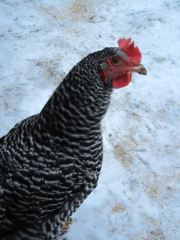I suspect I have an egg-eater in my coop. Lately, my egg production seems to be down from the usual six to about four a day. This alone wasn’t enough to tip me off to a bird with a possible predilection for eggs.
My hens have been confined to a small space now for several months. I’d expect anyone, including birds, to be stir crazy by this point and certainly wouldn’t be surprised to see a temporary reduction in egg production.

But, this morning when I did my usual coop check, a furtive motion by one of my young barred rocks caught my eye. She was thoroughly engaged with finishing off some tidbit – it looked suspiciously like an egg shell to me, but by the time I cornered her – she had swallowed the evidence.
The coop is on notice: egg-eating will not be tolerated, and the offender, should she be identifed, will be punished.
Egg-eating is one of the most heinous offenses a bird can level against its flock owner. Like all bad habits, it often develops out of boredom, and similarly, once started by one bird, can rapidly spread to others. Many flock owners, especially those that have small commercial laying flocks, have a zero tolerance policy. Once the egg-eater(s) is identified, it’s culled.
For those flock owners who prefer to try a less draconian approach, it is possible to stop the egg-eating, but it takes vigilance and rapid response before the habit spreads through the whole flock. As with the other really obnoxious bad chicken habits of cannibalism and feather-picking, beak-trimming is your answer to egg-eating. You can beak trim your entire flock (laborious and not recommended) but generally it is sufficient to just beak trim the egg-eaters.
To do this, the culprit(s) must be identified, so start visiting your flock frequently and watch their behavior. Once you have one or two suspects, segregate them from the flock for a few days and see if your egg numbers increase. You can also skip the segregation part and just beak trim them immediately.
Beak-trimming needs to be done properly, otherwise a bird may not be able to eat properly. Many commercial poultry operations routinely beak trim chicks using an automatic beak-trimming machine. When done at a young age, the beak does not regrow. However, in a situation such as the one here, where a fully-grown chicken is being trimmed to correct a pecking habit, the aim is to just remove a very small portion (less than an 1/8th of an inch) of the upper beak. This makes the beak trim temporary, and the upper beak will grow out again. If you choose to attempt beak-trimming, refer to a poultry book for illustrations and instructions before doing so.
Obviously beak-trimming is not for the faint of heart, so the best solution to egg-eating is prevention. Collect eggs often: two to three times a day. Keep nest boxes clean and comfy with good nesting materials to encourage hens to lay in the boxes and not on the floor.
For some reason this year, I have a couple of first-year hens that occasionally lay eggs on the coop floor – where they freeze and break; if I do now have an egg-eater, I think this is how she discovered eggs are tasty treats. If you feed your chickens their old egg shells (which is really not necessary given the vitamin and nutrition balance of commercial layer feed), make sure the shells are completely pulverized and do not resemble an egg shell.
Lastly, young birds are more prone to this habit than older ones. It often surfaces as the days get longer, and it is easy to imagine that it is more likely to occur in Alaskan flocks towards the end of a long winter after birds have been confined for several months. Providing distractions, like hanging a head of iceberg lettuce, to keep birds occupied and engaged in constructive rather than destructive pecking, may help as well.
Alaska Backyard Chickens is a resource for Alaskans and others living in northern climates who are interested in keeping chickens. Maintained by the Community Development Agent at the Cooperative Extension Service/University of Alaska Fairbanks, this site offers information for the hobbyist flock owner, such as what works (and doesn’t) in arctic coop design, and how to keep flocks healthy and productive through long winters. While small egg/meat producers are welcome, the site is designed for those who keep chickens to fulfill their household needs for eggs and meat. And of course – for people who just think chickens are cool birds!




